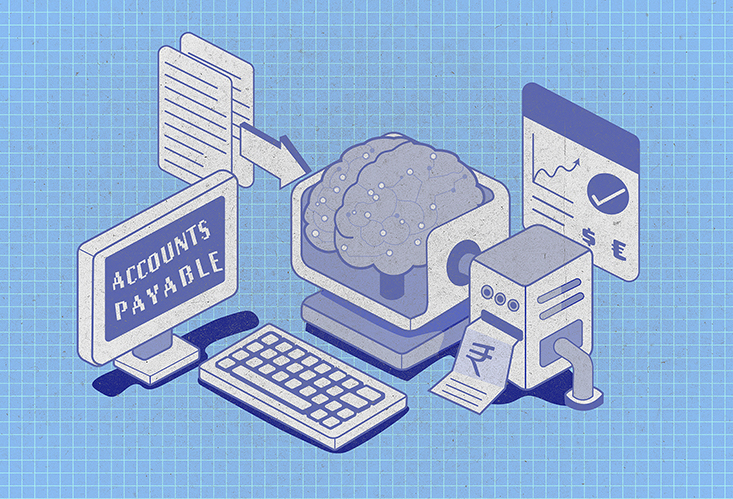Artificial intelligence (AI) is revolutionizing the finance industry, particularly in the realm of financial planning and analysis (FP&A). Harnessing machine learning algorithms is vital for FP&A functions to be more responsive, insightful, and efficient.
Some top-of-mind benefits AI in FP&A offers include real-time scenario planning and decision making, reducing employee costs, and gaining sufficient time for analysis and strategic thinking. In this article, we will explore how AI/ML is used in FP&A. We’ll cover:
- Why should FP&A leaders consider adopting AI?
- Transforming analysis, forecasting, and reporting with AI
- The use of AI in FP&A
- Data - The backbone of AI
- Embracing AI for meaningful results
Let’s begin.
Why should FP&A leaders consider adopting AI?
Global FP&A leaders reap immense benefits as they start welcoming AI. From enhanced accuracy to a competitive edge, all are some positive effects of AI embedded in their FP&A function.
Below we draw upon some of the compelling reasons.
Firstly, AI algorithms enhance efficiency by quickly processing large volumes of financial data, minimizing the risk of errors, and improving data integrity. This automation frees up time for FP&A leaders to focus on strategic analysis and decision-making.
Secondly, AI enables advanced analytics and provides valuable insights through techniques like predictive modeling and scenario analysis. FP&A leaders can identify hidden trends, risks, and opportunities that may not be easily apparent through traditional methods, leading to more accurate financial forecasting.
Lastly, AI tools provide real-time data access, allowing FP&A leaders to access up-to-date information for agile decision-making. This is crucial in dynamic business environments where timely and accurate data is essential for effective financial planning and analysis.
Transforming analysis, forecasting, and reporting with AI
FP&A leaders are often looked upon for delivering accurate forecasts and high-quality decision support. Below, we will uncover how AI helps them achieve them.
Analysis
The fundamental essence of any solution driven by AI lies in its meticulous analysis, capable of unveiling concealed insights that may elude human perception. Amidst numerous parameters demanding consideration, human experts can overlook certain aspects or misjudge the significance of specific factors.
In contrast, AI is renowned for its capacity to process multiple variables, assigning distinct weights to them, thereby attaining outcomes that can occasionally be unexpected.
Regarding FP&A teams, AI solutions primarily revolve around:
- Detecting patterns
- Analyzing money flow and transactions
- Identifying indications of fraud or dubious activities
Forecasting
By leveraging AI/ML techniques in forecasting, FP&A teams can obtain more accurate predictions and identify potential risks and opportunities. It enables organizations to adapt to dynamic market conditions and make agile financial plans and strategies.
Some common ways AI/ML can be applied in forecasting include —
- Historical data analysis: AI/ML algorithms analyze historical financial data to identify patterns, trends, and relationships among various variables. By recognizing these patterns, the algorithms can generate more accurate predictions for future financial outcomes.
- Predictive modeling: AI/ML models are trained on historical data to develop predictive forecasting models. These models take into account multiple factors and variables, such as sales data, market conditions, economic indicators, and customer behavior, to provide more precise forecasts.
- Time series analysis: Time series forecasting techniques, such as ARIMA (AutoRegressive Integrated Moving Average) and exponential smoothing, are often augmented with AI/ML algorithms. These algorithms help capture complex patterns and non-linear relationships in the time series data, leading to improved forecasting accuracy.
- Demand forecasting: AI/ML techniques, such as regression analysis and machine learning algorithms like random forests or neural networks, are employed to forecast product demand. By analyzing historical sales data and considering factors like seasonality, promotions, and external events, these models can predict future demand patterns.
- Risk assessment: AI/ML models can assess and quantify risks associated with financial forecasting. They can incorporate risk factors and uncertainties into the forecasting process, enabling organizations to make more informed decisions and develop contingency plans.
- Scenario analysis: AI/ML algorithms facilitate scenario modeling and analysis by simulating different scenarios based on changing variables and assumptions. This helps FP&A teams evaluate the potential impact of various scenarios on financial forecasts and make proactive adjustments.
- Real-time data integration: AI/ML algorithms can process and analyze real-time data streams, allowing organizations to incorporate up-to-date information into their forecasting models. This enhances the accuracy and responsiveness of the forecasts.
Reporting
By leveraging AI/ML in financial reporting, the FP&A process becomes more efficient, accurate, and data-driven.
Here are a few examples of how AI/ML is leveraged in this domain:
- Automated data collection and processing: AI/ML algorithms can automate the collection and processing of financial data from various sources, such as ERP systems, spreadsheets, and databases. This reduces manual effort and ensures accurate and timely data availability for financial reporting.
- Predictive analytics: AI/ML models can analyze historical financial data and identify patterns, trends, and correlations. By leveraging these insights, FP&A teams can make more accurate predictions and forecasts for budgeting, financial planning, and decision-making.
- Anomaly detection: AI/ML algorithms can detect anomalies or unusual patterns in financial data. This helps in identifying potential errors, fraud, or discrepancies in financial reporting, ensuring data integrity and compliance.
- Natural language processing (NLP): NLP techniques enable the extraction of meaningful information from unstructured data, such as financial reports, regulatory filings, and news articles. By automatically processing and analyzing textual data, AI/ML can provide valuable insights for financial reporting and decision-making.
- Automated report generation: AI-powered tools can automatically generate financial reports, statements, and dashboards. These tools can extract relevant data, perform calculations, and present the information in a visually appealing and easily understandable format, saving time and effort for FP&A professionals.
- Scenario modeling and sensitivity analysis: AI/ML can facilitate scenario modeling and sensitivity analysis by simulating various financial scenarios based on different parameters. This helps FP&A teams assess the potential impact of different factors on financial outcomes and make informed decisions.
The use of AI in FP&A
There are numerous ways in which AI/ML can improve FP&A operations. Some common use cases of AI include -
- Predictive analytics in forecasting
- Multiple-scenario planning
- Adaptability to change the product mix
- Price change
- Close books within days
- Process invoices and accruals faster
- Sales quota and territory planning
Let’s get into the details.
#1 Automated data aggregation
AI automates data aggregation and consolidation for FP&A teams, extracting relevant information from diverse sources. This eliminates the manual effort of collecting data from different systems, databases, and spreadsheets.
By streamlining this process, AI enables FP&A leaders to access accurate and up-to-date data, saving time and ensuring data integrity.
#2 Anomaly and error detection
Maintaining the integrity and sanity of financial data is the utmost priority for FP&A professionals. With nimble machine learning (ML) algorithms, you can detect deviations, outliers, and unusual behavior in financial data. These smarter algorithms ensure anomalies never slip through the cracks during the manual review.
Effective AI solutions introduce real-time analysis during the data entry phase. As financial data enters the system, it monitors and analyzes the information. It acts as a protective shield, preventing errors from entering the workflow. It also saves valuable time and resources that would have otherwise been spent on costly downstream corrections.
#3 Scenario analysis and sensitivity modeling
AI-powered tools enable FP&A leaders to conduct scenario analysis and sensitivity modeling by inputting variables, assumptions, and market conditions. This quickly generates multiple scenarios, providing insights into their impact on financial performance.
It helps evaluate strategic options and their corresponding financial outcomes, supporting well-informed decision-making.
#4 Forecasting and predictive analytics
AI works its magic by analyzing historical financial data, market trends, and macroeconomic indicators. It can generate accurate forecasts and robust predictive models. Simply put, it can project the company's financial performance with confidence.
Further, AI's deep analysis uncovers patterns and trends that may not be apparent to humans. It provides valuable insights that are much beyond mere gut feelings.
Armed with accurate forecasts and insights from AI, FP&A leaders can confidently:
- Make data-driven decisions
- Set realistic financial goals
- Adjust resource allocation
- Evaluate investment opportunities
#5 Financial performance analysis and reporting
AI-powered analytics tools enhance financial performance analysis and reporting for FP&A leaders. These tools can analyze vast amounts of financial data, identify crucial key performance indicators (KPIs), and generate interactive dashboards and reports.
FP&A leaders can leverage these insights to monitor performance, spot trends, and effectively communicate financial results to stakeholders.
#6 Decision support
ML algorithms analyze complex patterns in financial data and predict future outcomes. This process empowers FP&A leaders with a deeper understanding of decision consequences.
By simulating choices with hypothetical data and different scenarios, these algorithms provide insights for better-informed decision-making.
With decision support, FP&A leaders can:
- Evaluate courses of action
- Assess financial implications
- Make strategic choices
#7 Risk management
AI-powered risk management tools help FP&A leaders assess and mitigate risks more effectively. These tools analyze factors like market volatility, regulatory changes, and credit risks to identify potential threats to financial performance.
FP&A leaders can then use these insights to:
- Develop strategies for risk mitigation
- Stress test financial models
- Ensure resilience in their financial plans
#8 Expense management
AI can also be applied to expense management to streamline expense reporting and analysis. ML models can analyze expense data, identify patterns and trends, and provide insights that can help FP&A leaders optimize their expense management processes.
Further, by using AI-driven expense management, FP&A leaders can identify cost-saving opportunities, reduce waste, and improve their organization's overall financial health.
#9 Capital allocation optimization
AI algorithms offer valuable assistance to FP&A leaders in optimizing capital allocation decisions. By taking into account various factors like ROI, risk, cash flow projections, and strategic objectives, AI can identify the most efficient allocation of financial resources across projects, business units, or investments.
This empowers FP&A leaders to make well-informed decisions that maximize return on investment and drive financial success.
#10 Cash collection automation
ML models are employed to predict when customers will make invoice payments, enabling proactive collection efforts before payments become overdue. These predictions guide collections staff to prioritize at-risk accounts, optimizing their efforts.
Additionally, forecasted cash collections from these models contribute to ML-driven cash flow forecasting, providing valuable insights into overall cash flow management.
Data - The backbone of AI
Only when you feed accurate data, your predictive models and analytics will be reliable. Let’s consider the following scenarios and understand how AI is useful for:
1-10 or 50-member company
The organization is trying to figure out product-market fit. These types of companies are not aware of building data, utilizing data, or implementing predictive analytics. Utilizing AI to keep the data clean is a great add-on to them.
Mid-market company
You have too much data. Here, they are leveraging AI to structure available data, produce reports, and enable KPI measurement.
Scaling into bigger organizations
Here, you have different types of data like customer data, product data, and marketing data. By leveraging the benefits of AI, they could better organize data.
Embracing AI for meaningful results
To summarize, the rapid increase in data availability and the lowering of barriers to entry have created a huge opportunity for AI to transform FP&A. Adding to this, last month, PWC committed a 1 billion investment in Generative AI.
Using AI in FP&A helps in driving better business outcomes and enabling more informed decision-making. However, it should be used in conjunction with human expertise and domain knowledge.
Bluecopa helps you with data aggregation, financial data cleansing, forecasting, and financial analysis and reporting. Talk to us and start automating the above use cases in a jiffy.




.jpeg)

